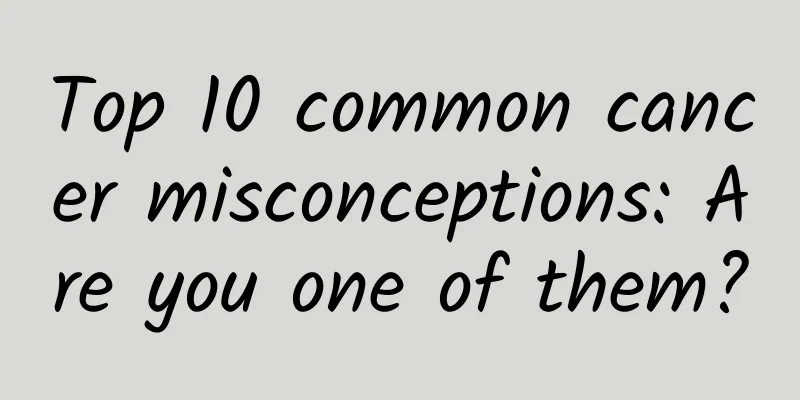Top 10 common cancer misconceptions: Are you one of them?

|
A report from the World Health Organization (WHO) shows that there are many misconceptions about cancer among the public, patients, and some medical staff. A survey conducted by the World Union Against Cancer (UICC) in 42 countries around the world on the perception that "getting cancer equals death" showed that 43% of Chinese people believe this view is correct, while only 13% of people in Western countries agree. The "Chinese Health Network" recently summarized the top ten common misconceptions about cancer through a survey, which is very representative. Myth 1: The main cause of cancer is genes A survey by the Chinese Health Network found that 1/5 of the respondents believed that cancer is mainly the result of genetic inheritance. In fact, this is only one of the factors that cause cancer. Environmental pollution, bad living and eating habits, excessive stress, etc. are all closely related to the occurrence of cancer. Cancer can be inherited to the next generation through gene mutations in reproductive cells, making the risk of cancer in the offspring much higher than that of the general population. For example, if a mother has breast cancer, the risk of breast cancer in her daughter is 2 to 3 times that of the general population. However, the probability of gene mutation and genetic characteristics of each cancer are different, and the genetic tendency is different. For example, colorectal cancer related to genetics only accounts for about 5% of all patients. Studies have confirmed that compared with genes, bad living habits (such as smoking, alcoholism, staying up late, stress, etc.) and environmental pollution (such as air pollution, chemical and pesticide residues, etc.) are more harmful to the body. Among them, unhealthy eating habits account for 35% and smoking accounts for 30%. For example, lung cancer is closely related to smoking and secondhand smoke; oral cancer and esophageal cancer are closely related to smoking, alcoholism, and chewing betel nuts; colorectal cancer is closely related to obesity, unhealthy diet, lack of exercise, etc. Myth 2: Cancer is not preventable Many people believe that cancer is difficult to prevent. However, the World Health Organization has proposed that 1/3 of malignant tumors can be prevented, 1/3 can be treated, and 1/3 can be cured. The initiative to prevent cancer is in everyone's own hands. The American Cancer Research Association pointed out that the simplest and most feasible way to prevent cancer is to eat more fruits and vegetables, which can reduce the risk of cancer by about 20%. The American Cancer Society recommends that people should eat at least 5 servings of fruits and vegetables every day (1 serving of fruits and vegetables is about 85 grams, equivalent to a small banana, medium apple or small carrot), reduce animal fat intake, maintain a standard weight, exercise at least 30 minutes a day, quit smoking and limit alcohol. Many cancers will send out unique signals in the early stages, which can be identified through regular physical examinations. As long as you stick to the first line of defense of "prevention is better than cure", establish a healthy lifestyle, avoid known cancer risk factors, and add the second line of defense of regular screening, it is not difficult to stay away from cancer. Myth 3: Radiotherapy and chemotherapy will definitely cause hair loss The survey shows that as many as 76% of respondents aged 50 to 59 believe that "hair loss is inevitable after receiving radiotherapy and chemotherapy", and 42% of respondents aged 40 to 49 also agree with this view. Cancer cells grow faster than normal cells, and chemotherapy drugs mainly work by inhibiting the growth cycle of cancer cells. However, during treatment, most chemotherapy drugs will "kill both good and bad", causing damage to normal cells in the body, especially gastrointestinal mucosal cells, hair follicle cells, and reproductive cells. For example, anthracycline chemotherapy drugs for the treatment of breast cancer are prone to cause hair loss; but some chemotherapy drugs used for gastrointestinal tumors only work on gastrointestinal mucosal cells, and patients are not prone to hair loss. In order to psychologically make it easier to accept the reality of hair loss, it is recommended that patients with long hair cut their hair short before receiving chemotherapy, and patients with short hair can have a short flat head. Myth 4: There is no cure for advanced cancer Most cancer patients are most afraid of hearing that they are in the late stage, with cancer cells metastasizing from the primary site to the liver, lungs, bones and other parts. The survey found that 46% of respondents aged 50 to 59 believed that there was no cure for advanced cancer. With the advancement of medicine, some cancers can still be cured even if they are already in the late stage when they are discovered, such as lymphoma and testicular cancer, which have a good prognosis. In particular, targeted therapy drugs continue to make breakthroughs, and even advanced lung cancer, breast cancer, etc. have the opportunity to be controlled for a longer period of time, and the survival period can be extended by several months or even years. Even if cancer metastasizes, the severity is different and cannot be generalized. As long as you follow the doctor's advice for treatment, there is still hope to "live with the tumor" for a long time. Myth 5: Fasting can kill cancer cells Many cancer patients believe that cancer cells can be "starved to death" by not allowing them to take in any nutrition, so some people adopt "fasting therapy" to control cancer. According to the survey, 14% of middle-aged respondents agree with this view, and the proportion of people over 60 years old is as high as 22%. Clinically, there have been liver cancer patients who only drank water and ate a small amount of fruits and vegetables to "starve" cancer cells. As a result, the cancer cells were not killed and they died of liver failure. Generally speaking, cancer patients who "fast" may lose 10 kilograms in a week, which is very destructive to immunity and makes cancer cells more likely to survive. Moreover, cancer cells are like "hooligans". In addition to causing damage near the primary lesion, they will also damage the adjacent organs and tissues and produce distant metastasis. During the metastasis, a large number of new blood vessels will appear, grabbing nutrients from other organs and tissues. However, studies have found that sugar is the favorite food of cancer cells. For example, the incidence of colorectal cancer, breast cancer, endometrial cancer, pancreatic cancer and prostate cancer is related to the love of sugar. A study by Harvard Medical School in the United States found that women who love to eat high "glycemic index" (GI) foods have a three times higher risk of colorectal cancer than normal people, while men have a 32% higher risk. Generally speaking, refined sugars and processed foods, such as sweet drinks, candies, cakes, biscuits and other snacks, are high GI foods, and cancer patients should eat less of them, or replace them with natural sugars found in vegetables and fruits. Myth 6: Vegetarians are less likely to get cancer According to a survey conducted by the Chinese Health Network, 24% of the respondents firmly believe that vegetarians have a low risk of cancer. Studies have shown that people who often eat a lot of meat and fish do have a higher risk of cancer, while vegetarians who eat fruits and vegetables every day and have adequate dietary fiber intake may have a lower risk of colorectal cancer than normal people. However, in order to make vegetarian food more delicious, some additives may be contained in the food, and many of them are often fried, which may cause excessive accumulation of oil, salt, and carcinogens in the long term, making it easier for cancer to target people than the average person. In addition, long-term vegetarianism may cause nutritional imbalance. A joint study by the Austrian Center for Social Medicine and Epidemiology and the Medical University of Graz found that vegetarians may increase their risk of cancer due to too little animal fat intake, which is 2 to 2.5 times that of people who love to eat meat. There is an "iron triangle" for cancer prevention, namely normal work and rest, regular exercise, and a balanced diet. Especially in terms of diet, you must not be partial or picky about food, try to focus on natural ingredients, limit processed products to 1 to 2 times a week, and eat 5 servings of fruits and vegetables of different colors every day to enhance the body's antioxidant capacity. Myth 7: Having many moles can lead to skin cancer "I heard that people with many moles have a high risk of cancer, especially moles on the soles of the feet are prone to melanoma." The survey shows that 61% of middle-aged and elderly people believe this view. Moles are divided into native moles that are born and moles that are formed by the environment and physical constitution. The latter are mostly related to melanin deposition. During adolescence and pregnancy, the increase of moles may accelerate. In middle age, the number of moles reaches a peak. Most people's moles are benign melanin moles, so there is no need to worry too much. If a mole has abnormal changes in color, size, shape, etc., special attention should be paid. 1. Changes in size, and there is a tendency to gradually spread outward, with a diameter greater than 0.6 cm. 2. There are peeling, bleeding, secretions, etc. 3. Asymmetrical shape, irregular and blurred edges. 4. Color changes, such as from brown to black or dark blue. 5. Abnormal touch, such as sudden protrusions and uneven touch. 6. Accompanying moles, many small moles suddenly grow next to a large mole that originally existed, and there is a tendency to merge. Myth 8: Large breasts are more likely to cause breast cancer "Large breasts are more likely to cause breast cancer" is also one of the misunderstandings of many people, but in fact, this is not scientific. "Large breasts" are not a high-risk factor for breast cancer, but family history is a high-risk factor. Other risk factors include: early menarche, late menopause, unmarried, childless, late childbearing, not breastfeeding, etc. It is often found in the outpatient clinic that most breast cancer patients come to the doctor only when they feel a lump or feel pain when wearing underwear. At this time, the cancer is mostly in stage 2 or later, and breast removal may be required. If it can be detected and treated early, the cure rate of breast cancer is very high. According to the stage-specific survival rate of newly diagnosed breast cancer in Taiwan from 2006 to 2010, the 5-year survival rate of cases from stage 0 to 1 is as high as more than 95%, and the survival rate of stage 2 is also as high as 88.7%. If it is discovered in stage 4, the survival rate is only 24%. It is recommended that women over 45 years old should self-examine their breasts every month and have regular physical examinations every year. If there is a family history, the screening age should be advanced to 40 years old. Myth 9: Eating organic food can prevent cancer Organic diet has become a new health trend in recent years. The survey found that 39% of respondents aged 50 to 59 believed that eating an organic diet can prevent cancer, and among people aged 13 to 19, this proportion is as high as 53%. Organic food refers to the use of chemical pesticides, chemical fertilizers, herbicides and other non-natural drugs in the planting or cultivation process, and maintaining the natural nutrients of the soil to improve the safety of the ingredients. Most of the current organic foods are vegetables and fruits. Some people believe too much that eating organic fruits and vegetables is good for the body, and they do not eat non-"organic certified" foods at all, such as pork that does not meet the "organic" breeding conditions, which can easily lead to nutritional imbalance and fail to prevent cancer. A 9-year study at the University of Oxford in the UK showed that women who consume organic food for a long time have no significant difference in the risk of cancer compared with women who never eat organic food. If you want to eat healthily, you need to diversify your diet, eat more seasonal foods, and eat some nuts every day. Myth 10: Acidic body is prone to cancer "The human body is healthy only when it is weakly alkaline", "Acidic physique is particularly prone to cancer"... In recent years, various statements about "acid-alkaline physique" have been widely spread and have become a popular concept in some health care product advertisements and health TV programs. But there is no such thing as acid-alkaline physique in science. First of all, there are many kinds of fluids in the human body, including intracellular fluid, extracellular fluid (tissue fluid, blood and lymph fluid), various digestive fluids secreted by the digestive system, sweat, urine, etc., and these fluids have their own pH values. The so-called "body fluid" statement is vague. Secondly, take weakly alkaline blood as an example, which contains several major buffer systems such as bicarbonate, phosphate, plasma protein, hemoglobin and oxyhemoglobin. These balance systems ensure that the pH value of the blood always fluctuates between 7.35 and 7.45. Finally, no matter what kind of food, when it reaches the stomach, it becomes acidic after mixing with strong gastric acid. When it reaches the intestines, it encounters a mixture of alkaline bile, pancreatic juice, and intestinal juice, and becomes alkaline again. After being absorbed by the human body, it does not affect the pH value of the blood. |
<<: Is acrophobia just a fear of the body? You think it’s too simple.
>>: The doctor said I have a "nodule". Is it okay not to have it removed?
Recommend
Dali said: A compulsory course for live broadcast products: five courses analyzing the underlying operational logic of product selection, testing, ranking, and promotion in live broadcast rooms
Dali said that live broadcast products are a must...
How should Chinese brands show their attitude after the emergence of GoPro and Tesla in the United States?
Everyone has his or her own dream and the desire ...
Would you like to know the 10 tips for Weibo operation and promotion?
Would you like to know about the ten tips for Wei...
50 financial secrets to comprehensively improve your wealth!
Money is not everything, but it can solve most pr...
2020 World Table Tennis Championships postponed! When will the postponement be held? Attached is the latest notice!
The latest news is that on February 25, the Inter...
How did I manage to attract one user with a small activity costing 1 yuan?
As a means with extremely strong explosive power ...
PPTV Laser Cinema MAX1 Review: The distance between the living room and the cinema is only one
Why do modern people spend less and less time wat...
Highlight the key points! All advertising resources in iQiyi’s information flow!
The latest data from iResearch MUT in April shows...
“Why do northerners eat dumplings during every festival?”
Today is New Year’s Eve! Do you plan to eat dumpl...
How do the ivy that can be seen everywhere under the viaduct "climb" up there?
Walking on the city streets lined with reinforced...
Tips for flooding the screen with Wechat Loan’s new customer acquisition activities!
I’m sure you were all flooded with messages about...
5 thoughts on community operations, and several points of focus on people and time periods!
In fact, this is a summary I wrote for myself. It...
How do you plan an event that everyone wants to attend?
Now with a mobile phone in hand, everyone can hav...
How to easily operate content-based products? Just learn these 5 tricks
In the Internet product market, content-based prod...
Today’s Rain|Misty rain in Jiangnan, night rain in Bashan, freezing rain…the “rain” in rain is not simple!
As the second solar term in spring, Rain Water ha...









